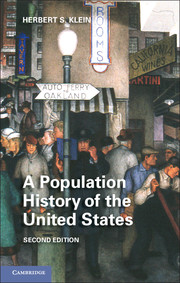Book contents
- Frontmatter
- Contents
- Graphs, Maps, and Tables
- Introduction to the Second Edition
- Introduction to the First Edition
- 1 Paleo–Indians, Europeans, and the Settlement of America
- 2 Colonization and Settlement of North America
- 3 The Early Republic to 1860
- 4 The Creation of an Industrial and Urban Society, 1860–1914
- 5 The Evolution of a Modern Population, 1914–1945
- 6 The Baby Boom and Bust and the New New Immigrants, 1945–1970
- 7 An Advanced Industrial Society, 1970–2011
- Appendix Tables, Graphs, and Maps
- Bibliography
- Index
- References
1 - Paleo–Indians, Europeans, and the Settlement of America
Published online by Cambridge University Press: 05 June 2012
- Frontmatter
- Contents
- Graphs, Maps, and Tables
- Introduction to the Second Edition
- Introduction to the First Edition
- 1 Paleo–Indians, Europeans, and the Settlement of America
- 2 Colonization and Settlement of North America
- 3 The Early Republic to 1860
- 4 The Creation of an Industrial and Urban Society, 1860–1914
- 5 The Evolution of a Modern Population, 1914–1945
- 6 The Baby Boom and Bust and the New New Immigrants, 1945–1970
- 7 An Advanced Industrial Society, 1970–2011
- Appendix Tables, Graphs, and Maps
- Bibliography
- Index
- References
Summary
There is little question that the early demographic history of North America is still one of the most controversial fields in current scholarship. To the older work of archeologists, geologists, and linguists has been added the new work of geneticists and physical anthropologists, all of which has often overturned long-established dogmas. The pre-history of North America also remains one of the areas in which all types of enthusiasts have created popular origin myths that still dominate some parts of national thought. In this chapter I will lay out the current state of the debate about the origins of mankind in the Americas and the dating and distribution of the pre-Columbian populations over time and space. I will show how this distribution of the American Indian population by 1492 influenced the subsequent European settlement patterns that evolved within the Americas.
The region that today forms the continental boundaries of the United States may have first been settled by humans as early as 30,000 b.p. (or years before the present era), but no later than 15,000 b.p. Homo sapien Neanderthals emerged in eastern Africa some 300,000 to 200,000 years ago. They spread throughout the Euroasian land mass and were slowly replaced by modern Homo sapiens about 40,000 years ago. Given that no Neanderthal remains have been found in the Americas, it is now assumed that human migrations did not occur before this replacement had occurred. It is also generally accepted that mankind and numerous species of animals arrived in America via a land bridge across the Bering Strait, which connected the Americas to the Eurasian continent during the late Pleistocene period. This causeway was intermittently open from 70,000 b.p. until 15,000 b.p. Given the harsh Nordic conditions, people could not survive in these regions until they developed adequate protection. The oldest known clothing in Asia is dated to 25,000 b.p. Those Homo sapiens who migrated into America came fully skilled in making tools, knew fire, and wore clothing made from animal skins. The accumulation of recent genetic evidence suggests that one or more founding migrations separated from their Northeastern Asian origin groups sometime between 30,000 and 20,000 b.p; dental evidence appears to support a formal separation between Asians and Americans by about 15,000 b.p.
- Type
- Chapter
- Information
- A Population History of the United States , pp. 11 - 33Publisher: Cambridge University PressPrint publication year: 2012



